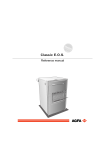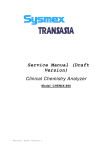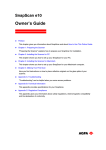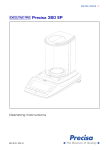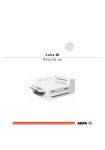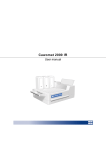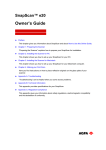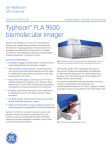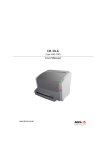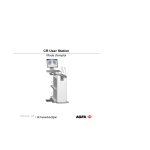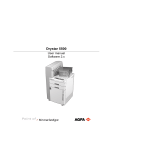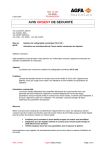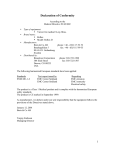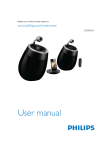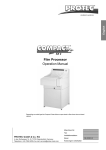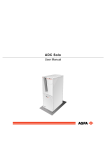Download Agfa Classic E.O.S - User manual
Transcript
Classic E.O.S. User manual © Agfa-Gevaert N.V. 2000. No parts of this document may be reproduced, copied, adapted or transmitted in any form or by any means without the written permission of Agfa-Gevaert N.V. Agfa-Gevaert N.V. makes no warranties or representation, expressed or implied, with respect to the accuracy, completeness or usefulness of the information contained in this document and specifically disclaims warranties of suitability for any particular purpose. Agfa-Gevaert N.V. shall under no circumstances be liable for any damage arising from the use or inability to use any information, apparatus, method or process disclosed in this document. Agfa-Gevaert N.V. reserves the right to make changes to this document without prior notice. Agfa-Gevaert N.V., Septestraat 27, B-2640 Mortsel, Belgium. Classic E.O.S. is a trademark of Agfa-Gevaert N.V., Belgium Agfa and the Agfa-Rhombus are trademarks of Agfa-Gevaert AG, Germany 2 1281C GB 20001204 Table of contents Chapter 1: Introducing the Classic E.O.S. .............................................................. 5 Welcome to the Classic E.O.S................................................................................. 6 Safety precautions................................................................................................... 7 Safety compliance ................................................................................................... 8 The control panel..................................................................................................... 9 Switching the Classic E.O.S. on ............................................................................ 12 Switching the Classic E.O.S. off ............................................................................ 14 Chapter 2: Basic operation .................................................................................... 15 Processing films .................................................................................................... 16 Processing an emergency film............................................................................... 19 Chapter 3: Advanced operation ............................................................................. 21 Recommended chemicals ..................................................................................... 22 Customization........................................................................................................ 23 Survey of the preventive maintenance work .......................................................... 24 Troubleshooting checklist ...................................................................................... 26 Appendix A: Equipment information sheet .......................................................... 29 Specifications ........................................................................................................ 30 Accessories ........................................................................................................... 34 1281C GB 20001204 3 4 1281C GB 20001204 Chapter Introducing the Classic E.O.S. This chapter introduces the Classic E.O.S. to the user and draws the attention to some important safety precautions. ❑ Welcome to the Classic E.O.S. ❑ Safety precautions ❑ Safety compliance ❑ The control panel ❑ Switching the Classic E.O.S. on ❑ Switching the Classic E.O.S. off 1 Welcome to the Classic E.O.S. The Classic E.O.S. is a processor for medical X-ray films developed by Agfa. The Classic E.O.S. cannot process rollfilms. The Classic E.O.S. offers the following features: ■ Three fast processing cycles for optimal processing quality in accordance with the film type that is used: High Throughput (HT), Intermediate Processing (IP) and Rapid Processing (RP). ■ Operation of the processor can be completely customized by means of the following processing parameters: • developer temperature, • dryer stage, • developer replenishment rate, • fixer replenishment rate, • jog-cycle function (standby developer and fixer replenishment), • initial developer and fixer replenishment function. ■ The Classic E.O.S. (‘Ecological Optimized System’) features a twin fixer tank system which reduces substantially the silver carry-over to the rinse water tank. • After development, the exposed film enters the first fixer tank, where most of the silver is removed from the film. • The film then is transported through the second fixer tank, to be treated again with fresh fixer. • As a consequence, when the film is passed to the rinse water tank, silver freight carry-over will be very low. ❖ Agfa can guarantee optimal film quality and compliance with statutory regulations only if Agfa materials are used. 6 1281C GB 20001204 Safety precautions General safety instructions ■ The Classic E.O.S. was designed for processing medical X-ray films, and should only be used for this purpose. ■ The processor may only be operated by qualified staff, skilled on the machine. ■ Make sure that only by Agfa authorized personnel has access to the processor. ■ Only trained and authorized service personnel can make repairs or changes to the processor. ■ If there is visible damage to the machine casing, the processor should not be started or used. ■ Do not override or disconnect the integrated safety features. ■ Disconnect the processor from the mains before performing any maintenance activities. ■ Like all technical devices, the processor must be operated, cared for and serviced correctly, as described in the documentation provided with the machine. ■ If the processor is not operated correctly or if you do not have it serviced correctly, Agfa is not liable for resulting disturbances, damages or injuries. ■ When installing the processor, care must be taken to ensure that there is either a mains plug or an all-cable disconnecting device in the internal installation fitted near the processor and that it is easily accessible. ■ If connections with other components or assemblies are made, Agfa can guarantee safety only for combinations which are approved by Agfa. ■ If you notice conspicuous smoke or noise, disconnect the processor immediately. 1281C GB 20001204 7 Special instructions for the handling of chemicals ■ When handling chemicals, you must observe safety and environmental regulations as well as the operating and warning instructions accompanying the chemicals. ■ Wear stipulated protective clothing and safety goggles. ■ When disposing of chemicals and waste water, you must comply with the local regulations concerning waste water and environmental protection. ■ If chemicals get into your eyes, immediately rinse your eyes with cold water and consult a physician. ■ Do not inhale vapor from chemicals. Make sure that there is sufficient ventilation where the processor is installed, i.e. air exchange that is at least ten times the space volume per hour. ■ Always comply with the installation instructions. ■ Regularly check all connections to the processor for tightness. ■ If liquid gets into the inside of the processor (due to spills), disconnect the processor from the mains immediately and have the device cleaned thoroughly by service personnel. Safety compliance ■ This processor complies with the safety regulations EN 60950: 1997 (IEC 950) and EN 60601-1-2: 1993, UL 1950 and CSA C22.2 No. 950 and with the regulations on radio interference suppression EN 50081-1, EN 55011 and FCC 47 Part 15, Subchapter B, Class A. ■ The non-return water connection system complies with DIN 1988. 8 1281C GB 20001204 The control panel Control panel keys Key 1281C GB 20001204 Key description Action Up key. • To scroll upward through multiple choices in a field. Down key. • To scroll downward through multiple choices in a field. Escape key. • To quit a submenu without saving any changes. Confirm key. • To select a menu item. 9 Control panel display The LCD display of the control panel consists of two lines of 16 digits, located above the keys on the control panel. 5($'< 53 d& or, e.g.: cHDWLQJ GHYHORSHU The display keeps the user informed on the status of the processor, e.g. when failures occur by showing an appropriate message. Refer to ’Troubleshooting’ on page 73 of the Classic E.O.S. Reference manual. 10 1281C GB 20001204 Audio signals The Classic E.O.S. also informs you about its status by means of beeps. The length of the beep indicates the system’s response to a key command. ◆ A short beep means that Classic E.O.S. accepts the command and begins the operation. ◆ A long beep signifies that the Classic E.O.S. rejected the command or the action or process failed. ◆ An interval beep accompanies an error status message. Refer to ‘Troubleshooting checklist’ on page 26. 1281C GB 20001204 11 Switching the Classic E.O.S. on ❖ When operating the processor for the first time, make sure that the processor has been installed in accordance with the Agfa installation instructions. 1 Locate the main switch and place it in position ‘I’. Do not touch the switches with wet fingers! The processor starts an initialization procedure that may take 15 to 20 minutes. During the initialization phase an emergency film can be processed if a film is introduced on the feed table. Refer to ‘Processing an emergency film’ on page 19. 2 The developer and fixer are heated. cHDWLQJ GHYHORSHU or, e.g.: 53 d& You can watch the progress of heating as the temperature indication changes accordingly. 12 1281C GB 20001204 3 After a while, the following message indicates that the processor is ready for operation: 5($'< 53 d& ❖ The actual temperature to be reached depends upon the setting for the actual processing cycle. Refer to ’Developer temperature’ on page 36 of the Classic E.O.S. Reference manual. After switching on 1 Introduce large sheets of blank films (cleaning films), e.g. film size 35x43 cm/ 14x17 inch, when the processor has been on standby for an extended period of time, e.g. overnight, to remove any deposits or residue from the transport path of the film. 2 It might be necessary to initiate an additional developer replenishment, depending on the start-up developer replenishment setting, which can be set ON or OFF. If set ON, an automatic replenishment is initiated automatically when switching the processor on. Refer to ’Setting the start-up replenishment function’ on page 47 of the Classic E.O.S. Reference manual. 1281C GB 20001204 13 Switching the Classic E.O.S. off Before switching off Verify that no film is being processed before switching off the processor. Switching off It is recommended to switch the processor off: ◆ when you do not intend to process films for the next couple of hours, ◆ at the end of the day. 1 Place the main switch in position ‘0’. Do not touch the switch with wet fingers! 2 The water tank is drained automatically. If the processor is used continually, the water tank will be drained automatically once per period of twenty-four hours. The default time setting is 02:00 h; the time can be changed by your local service organization. This draining operation takes approx. 8 minutes. 14 1281C GB 20001204 Chapter Basic operation This chapter holds basic information on how to process films both under normal conditions and in emergency situations. ❑ Processing films ❑ Processing an emergency film 2 Processing films Processing a film is very easy and straightforward: you just have to place the exposed film on the feed table and feed it into the feed slot of the Classic E.O.S. The Classic E.O.S. will then process the film and deposit it in the exit tray. The Classic E.O.S. can process all common brands of medical X-ray film suitable for machine processing. You can apply sheet films of the following sizes: ◆ maximum width: 43.2 cm (17 inch), ◆ smallest size: 10 x 10 cm. DO NOT process rollfilm on the Classic E.O.S. Processing under normal conditions Proceed as follows: 1 Check whether the processor is switched on and ready for operation. The display should show, for example, the READY message: 5($'< 53 d& Introduce large sheets of blank films (cleaning films), e.g. film size 35 x 43 cm, when the processor has been on standby for an extended period of time, e.g. overnight, to remove any deposits or residue from the transport path of the film. 16 1281C GB 20001204 2 Place the sheet of film to be processed on the feed table. Make sure that the film edge is aligned with the feed slot. The processor accepts the film and starts processing it. The following message is shown: 3OHDVHZDLW 3 Wait until you hear a short beep, and the READY status message reappears. 5($'< 53 d& You can now introduce the next film to be processed. 1281C GB 20001204 17 Processing narrow films You can place narrow films side by side on the feed table to have them processed simultaneously. However, make sure these films do not overlap. You can introduce 2 sheets of 10 x 10 cm film simultaneously as shown below. DO NOT process roll film on the Classic E.O.S. 18 1281C GB 20001204 Processing an emergency film It may happen that you have one or more films to process at a time when the Classic E.O.S. is not completely ready for operation. This can be e.g.: ◆ when the Classic E.O.S. is initializing and the developer has not yet reached the set temperature, ◆ when an error status message is displayed. Still, the Classic E.O.S. enables you to process films in these conditions. Films thus processed are referred to as ’emergency films’. Emergency films do not always meet the quality standards of development, rinsing or fixing. In addition, the archivibility of films thus processed is not always guaranteed. Under particular circumstances, the film might be useless to make a proper diagnosis! Proceed as follows to process emergency films: 1 Check the display. ❖ Caution: emergency film processing is not possible if, e.g., the following message appears: (UURU 6HHPDQXDO √ Refer to ’Emergency film processing’ on page 75 of the Classic E.O.S. Reference manual. 2 Place the emergency film to be processed on the feed table. The processor accepts the film automatically and displays the following message on the control panel: (PHUJHQF\ILOP 3OHDVHZDLW 3 Wait until you hear a short beep. You can now introduce the next emergency film to be processed. 1281C GB 20001204 19 20 1281C GB 20001204 Chapter Advanced operation This chapter gives an overview of functions for the advanced user: ❑ Recommended chemicals ❑ Customization ❑ Survey of the preventive maintenance work ❑ Troubleshooting checklist 3 Recommended chemicals The tables below list the recommended chemicals, as a function of the processing cycle, temperature level and the replenishment quantity. Chemicals Developer and fixer temperature HT IP RP Developer G 138 i 38 °C 37 °C 34 °C Fixer G 334 i/ G 338 34 °C 34 °C 34 °C Chemicals Replenishment quantity HT / IP / RP Developer G 138 i 400 ml/m2 Fixer G 334 i/ G 338 400 ml/m2 The replenishment quantities as listed in the above table are valid only if your film consumption exceeds 5 m2 film/day and is based on a regular daily use. If your daily film consumption is lower, you can initiate a chemical jog cycle, which provides additional replenishment rates that compensate for low film usage. When handling chemicals, make sure to take notice of the warning instructions on the packing material. Refer to ‘Special instructions for the handling of chemicals’ on page 8. Refer to ’Customization’ on page 29 of the Classic E.O.S. Reference manual. 22 1281C GB 20001204 Customization Overview of recommended settings The table below lists the recommendations for optimal processing stability, depending on your specific workload. Developer replenishment rate more than 5 m² film/day 3 to 5 m² film/day less than 3 m² film/day daily use irregular use daily use irregular use daily use irregular use 400 ml/m² 400 ml/m² 600 ml/m² 600 ml/m² 600 ml/m² 600 ml/m² Standby developer and fixer replenishment - jog cycle (*) more than 5 m² film/day 3 to 5 m² film/day less than 3 m² film/day daily use irregular use daily use irregular use daily use irregular use OFF OFF OFF OFF ON ON Start-up replenishment function more than 5 m² film/day 3 to 5 m² film/day less than 3 m² film/day daily use irregular use daily use irregular use daily use irregular use OFF ON OFF ON OFF ON (*) The default setting is AUTO: the developer and fixer jog cycle is set automatically ON if the daily film consumption is less than 3 m². It is set automatically OFF if the daily film consumption is more than 3 m². Refer to ’Customization’ on page 29 of the Classic E.O.S. Reference manual. 1281C GB 20001204 23 Survey of the preventive maintenance work Preventive maintenance and cleaning of the Classic E.O.S. at regular intervals will keep the Classic E.O.S. running smoothly and ensure optimum processing quality. Maintenance table A survey of this cleaning and maintenance work is listed in the table below. The procedures themselves are explained in detail in the Classic E.O.S. Reference manual (page references). Interval Maintenance work Page Clean the feed table. 54 If possible, switch the Classic E.O.S. off overnight. 20 Weekly Clean the tank covers and film guide elements. 56 Monthly Check the ground fault switch. Daily Clean the tanks and roller sets. 59 Clean the squeegee roller set. 66 Clean the pumps. 68 Clean the dryer roller sets. Procedure for skilled service personnel only. 97 Every six months Clean the water filter. Procedure for skilled service personnel only. 104 Yearly Have the rack bearings and gears checked by your local service organization. Every three months Clean the film scanner. Ad hoc 54 Have the replenishment settings checked by your local service organization. Have the rack bearings and gears checked by your local service organization. If you do not comply with the above-mentioned maintenance instructions, there might be a loss of photographic quality. If the processor is not maintained correctly, the proper functioning and the safe operation of the machine are no longer guaranteed. 24 1281C GB 20001204 Refer to ’Advanced operation’ on page 21 of the Classic E.O.S. Reference manual. Maintenance message The Classic E.O.S. must be checked and serviced periodically by your local service organization (default period: every six months). If the following maintenance message is displayed, you must call your local service organization. 3OHDVHZDLW alternating with 0DLQWHQDQFH ❖ The message will continue to appear at start of work when processing the first four films of the day, until service takes place. When not complying with the above-mentioned maintenance instructions, there might be a loss of photographic quality. If the processor is not maintained correctly, the proper functioning and the safe operation of the machine are no longer guaranteed. 1281C GB 20001204 25 Troubleshooting checklist A survey of possible faults is listed in the table below. The troubleshooting procedures are explained in detail in the Classic E.O.S. Reference manual (page references). Error status Refer to You try to feed a film but it is not accepted. The processor is out of operation. 77 Message ‘Developer level low’ or ‘Fixer level low’. The developer or fixer level is too low. 79 Message ‘Water level low’. The water level is too low. 84 An accepted film is not deposited in the exit tray. Jammed film. 85 The processed film is still moist, or is deformed or shows drying patterns. Film quality problems. 87 Message ‘Check water pump’. Clean the water pump. If that does not help, contact your local service organization. 68 ‘Error 502 - See manual’ message. The developer temperature is too low. 88 ‘Error 504 - See manual’ message. The fixer temperature is too low. 90 ‘Error 514 - See manual’ message. Clean the pumps (Developer Fixer 1 - Fixer 2). If that does not help, contact your local service organization. 68 ‘Error 505 - See manual’ message. Failure of the dryer heaters. Procedure for skilled service personnel only. ‘Error 501’, ‘Error 503’, ‘Error 510’, ‘Error 506’ and other ‘Error XXX’ messages. Contact your local service organization. Messages when accessories are connected. 26 Page 101 92 1281C GB 20001204 An interval beep accompanies the messages. ❖ You can interrupt the beeping by pressing the confirm key. Refer to ’Troubleshooting’ on page 73 of the Classic E.O.S. Reference manual. 1281C GB 20001204 27 28 1281C GB 20001204 Appendix Equipment information sheet A Specifications Product description Type of product Medical film processor Commercial name Classic E.O.S. Model number 5270/xxx Original seller/manufacturer Agfa-Gevaert NV-Mortsel Labelling CE 93/42 EEC ‘Medical Devices’ (Europe) TÜV-Certification Mark EN 60950 c-UL-us-Listing Mark UL 1950, CSA 22.2 No. 950 (US/CAN) Dimensions Length, feed table and receiving tray excluded 740 mm Length, feed table and receiving tray included 1270 mm Width 710 mm Height 1130 mm Weight Empty ca 135 kg With filled tanks ca 165 kg Materials 30 Equipment does not contain: CFC or HCFC, asbestos, PCB or PCT, mercury, cadmium, lead as additive to plastic Plastic parts > 50 g marked according to ISO 11469 1281C GB 20001204 Electrical connection Operating voltage 200 - 240 V Mains fuse protection 15/16 A Mains frequency 50/60 Hz Power consumption Standby (room temperature ~ 20 °C) 0.25 kWh During film processing 2.1 kWh (max. 3.45 kWh) Environmental conditions Relative humidity 10 % - 80 % Room temperature (without cooling system) 10 °C - 30 °C Room temperature (with cooling system) 10 °C - 35 °C Recommended consumables Developer G 138 i Fixer G 334 i/G 338 Film all Agfa medical X-ray films Water tap water Tank volumes (with roller sets inserted) Developer tank ca 8.8 l Fixer tank 1 ca 10 l Fixer tank 2 ca 5.8 l Water tank ca 5.8 l Developer temperatures (default values upon installation) RP processing cycle 34 °C IP processing cycle 37 °C HT processing cycle 38 °C 1281C GB 20001204 31 Fixer temperatures Fixer tank 1 Not regulated Fixer tank 2 34 °C in all processing cycles Replenishment rates (default values upon installation) Developer 400 ml/m2 at > 5 m2 film/day Fixer tank 2 400 ml/m2 at > 5 m2 film/day Film characteristics Smallest film size 10 x 10 cm Max. film width 435 mm Roll film Not possible Water supply Compliant with DVGW DIN 1988 Teil 4/1988 (Germany) Water temperature min. 5 °C; max. 5 °C under set developer temperature Water pressure 2 - 6 bar pH 6.5 - 8 Minimum conductivity min.: 3 µS/cm Water consumption During film processing max. 3 l/min Water consumption can be adjusted by your local service organization: between 3 l/m² and 30 l/m² (in steps of 1 l/m²) Standby 32 0 l/min 1281C GB 20001204 Physical emissions Noise emission (sound power level according to ISO 7779) • During film processing max. 48 dB(A) • Standby max. 35 dB(A) Radio frequency emission according to CE requirement Heat emission • During film processing total: 7560 kJ/h; into the room: 3240 kJ/h • Standby total: 900 kJ/h; into the room: 900 kJ/h Chemical emissions (equipment & consumables) Depending on processing conditions, and type of chemicals; in direct surroundings of equipment, when using recommended chemicals, and if installed according to instructions SO2 (sulfur dioxide) below TLV values CH3COOH (acetic acid) below TLV values Process data (throughput for 35x35 cm sized films) RP processing cycle 110 films/hour IP processing cycle 150 films/hour HT processing cycle 220 films/hour End of Life Estimated product life (if regularly serviced and maintained according to AGFA instructions) 1281C GB 20001204 7 yrs. 33 Accessories ◆ Anti-algae kit. ◆ Water pressure reduction. ◆ Replenishment tanks 2 x 30 l. ◆ Replenishment tanks 2 x 80 l. ◆ E.O.S. Fix. ◆ Chemix. 34 1281C GB 20001204 1281C GB 20001204 35 Printed in Belgium Published by Agfa-Gevaert N.V., B-2640 Mortsel-Belgium 1281C GB 20001204





































